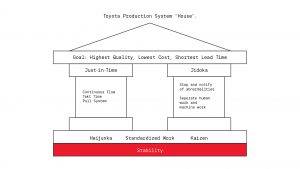Just as one would bring dirt to the roots of the tree to be transplanted – ideas should be brought to all relative stakeholders before implementation is pursued – surround the stakeholders with these ideas, make sure they are comfortable, make sure they buy in to an idea, make sure they can thrive in the ecosystem you are about to create before implementation begins.
Lean manufacturing has turned into a massive, convoluted mess of rules and tools that more often than not miss the true essence of lean manufacturing’s roots. To fully understand lean manufacturing, we need to look back to its beginnings and understand why it became so successful in the first place.
Lean originally came from Japan – more specifically within Toyota. In 1948, Taiichi Ohno and Eiji Toyoda began developing the Toyota Production System (TPS), lean manufacturing’s philosophy and practice. TPS was created as a framework to capture the methodology set forth by Toyota founder Sakichi Toyoda and to compete with the American automobile industry upon conclusion of the Second World War. It is essential to understand the foundation of TPS as it really highlights the pure essence of lean manufacturing.

In Taiichi Ohno’s Toyota Production System: Beyond Large-Scale Production (1978), he discusses an idea that he recognizes as the spark that lead to the present TPS. Ohno talks about working in a weaving plant for Toyoda Spinning and Weaving in 1937 when he heard a man saying that a German worker could produce three times as much as a Japanese worker and an American worker three times more than a German. Ohno could not believe these numbers as it would not require nine Japanese workers to match one American. Surely the Americans could not exert nine times the effort; therefore, he concluded there must be waste in the Japanese systems. It’s important to understand that this idea is the basis for TPS and lean manufacturing as a whole. At its purest essence, lean manufacturing is simply an elimination of waste.

There are many aspects to lean manufacturing and TPS other than waste elimination. However, one could argue that in essence all other aspects work towards waste reduction. Focusing on the major pillars of TPS, the most important principles are Just-in-Time (JIT) methodology, Jidoka, Kaizen, Standardised Work, and Heijunka. As we dive into these principles it becomes quite apparent that all are focused on waste elimination.

- Just-in-Time (JIT) Principle
In a nutshell, JIT is about operating with the minimum amount of resources required to consistently deliver, to do just what is needed, in just the amount of time required, just where it is need, and just when it is needed. In other words, JIT is doing as little work as required with as little of material as required to still consistently deliver a consistent product – whatever is required to produce the product and nothing more (no waste!).
- Jidoka Principle
Jidoka’s major points are to detect abnormalities, to stop and respond to every abnormality, to separate machine work from human work, and to enable machines to do these things autonomously. In this way the principle works to eliminate waste by not allowing value to be added to products that are already defective and correcting processes before they produce multiple defective components. The principle also eliminates wasted labour by better connecting humans and machines to produce work cells with the highest possible output and quality.
- Kaizen Principle
Kaizen is simply a continuous improvement; which translates: change (kai) good (zen). How do you make positive changes? By eliminating waste!
- Standardised Work
This ensures that operators know exactly what to do and what tools to use – eliminating waste from searching from tools/materials and gathering additional info for part processing.
- Heijunka
Heijunkawhich translates: “leveling”, is all about planning production levels that approach the instantaneous demand of the customer or market every day. This concept is a bit more abstract than some of the other major TPS pillars but a little insight into its origins help us better understand the true essence of Heijunka. Years ago, Toyota realised that batching was a bad idea. They reached this conclusion by understanding that no system can be continuously responsive to changing orders without suffering from mura and muri.
Mura is unevenness in productivity and quality; muri is the overburden of machines, managers, and production associates. Together mura and muri combine to create waste (or muda). Essentially Heijunka is about minimizing changeover times to allow for flexible production plans which can meet customer demands while optimizing the amount of time (and when that time is spent) on a specific product. Again the root of Heijunka is waste elimination.
Proper lean implementation requires a lot of planning. It is important to understand that TPS is not a book of hard and fast rules. It is a philosophy to live by. The Japanese language is very good at taking a complex idea and condensing it into a concise word; this is a concept that is very foreign in the English language. Heijunka is a great example of this. Although just one simple word, it carries with it a multitude of ideas that must be correctly understood before implementation begins. This is where we sometimes get the concept of lean manufacturing wrong in today’s high speed, instant gratification world.
Lean is not about giving employees a presentation to tell them what lean is and then forcing managers and teams to start using the lean manufacturing tools given to them. Lean is a philosophy that must exist and be fully grasped by all employees from the janitors to the CEO. A philosophy lives in the minds of people and guides their every direction and at the end of the day a company is nothing other than the people it employs.
This is how we should think of lean, not as a set of tools that must be used as a means to an end. In fact, one lean principle exemplifies the importance of treating lean this way for successful implementation. This word is Nemawashi, which translates “going around the roots”. The literal origins of the word come from digging around the roots of a tree to prepare it for transplant. The roots would then be surrounded by dirt from the new location so that it can be accustomed to the new location before it gets there. The same principles must be used for successful lean implementation (or any implementation for that matter).
Just as one would bring dirt to the roots of the tree to be transplanted, ideas should be brought to all relative stakeholders before implementation is pursued. Surround the stakeholders with these ideas, make sure they are comfortable, make sure they buy in to an idea, and make sure they can thrive in the ecosystem you are about to create before implementation begins. Besides faster adoption, this concept helps yield continuous improvement benefits to the newly implemented system.
Because new users now understand the philosophy and reasoning behind the system, they can better contribute to new ideas and improvements rather than just taking the tools given to them and simply using them as they were told. This is the point that we often miss when implementing lean manufacturing in today’s world and is a point we must emphasise to change so as not to run the concepts of lean manufacturing into the ground.
We need to truly get to know the roots of lean and understand why it exists. Let lean principles guide your thoughts on a daily basis. Look at all problems from the frame of lean principles. Think of the tools already at your disposal to tackle a problem but also understand the creative freedom that you have to solve a problem while still staying true to lean’s roots. And most importantly, lean cannot live in just an individual’s mind or just the collective minds of the industrial engineering department. Lean principles must be truly understood and practiced by all members of an organization to ensure its most impactful benefits are felt.
Happy Kaizen!